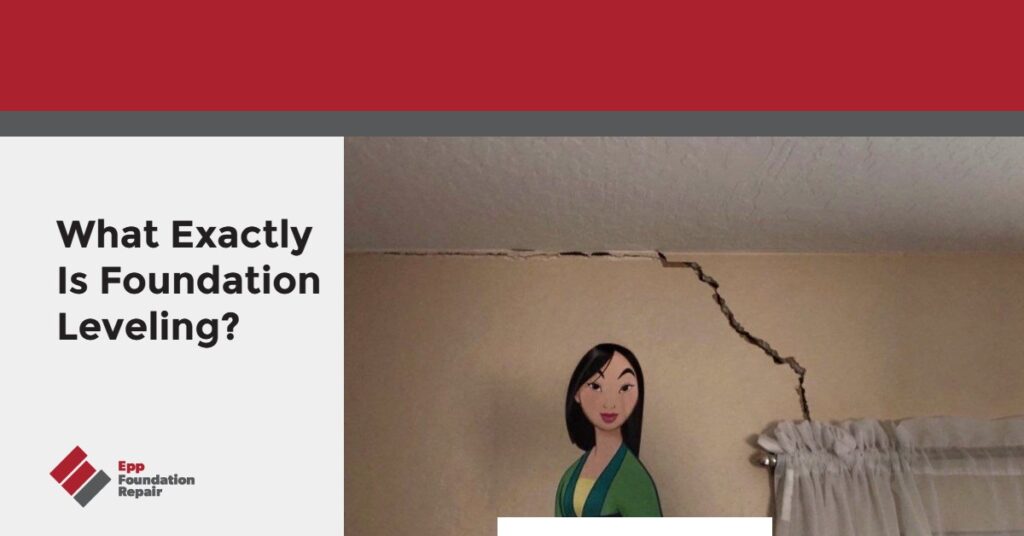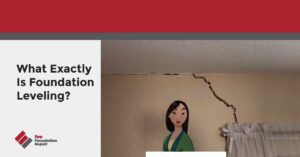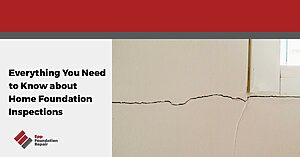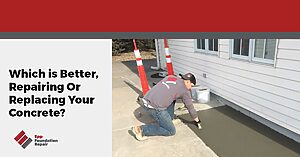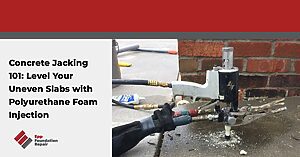If you’re looking for information about foundation leveling, this article has what you need. You’ll learn what foundation leveling is, why it might be needed, signs your home might require foundation leveling, and more.
So, What Is Foundation Leveling?
When people use the term “foundation leveling” they usually mean underpinning a foundation experiencing differential settlement in order to prevent further settlement. Underpinning might be done using push piers, helical piers, or slab piers.
Although the word “leveling” is included in the term, most of the time leveling a settled foundation can’t be done without significant cost because it requires excavating the entire foundation down to below the footing and removing all that soil. Most homeowners aren’t willing to pay for this.
What foundation leveling via underpinning does do is prevent further differential settlement.
So, What Is Differential Settlement, And What Causes It?
A structure experiencing differential settlement is settling into the soil unevenly. (See the below illustration). This contrasts with uniform settlement when a foundation sinks slightly into the ground – but evenly – after construction. A slight amount of uniform settlement after construction is usually nothing to worry about.
Differential settlement is another matter.
Differential settlement is not typical and puts stress on the foundation resulting in problems like uneven floors, problems opening and closing doors and windows, and wall cracks.
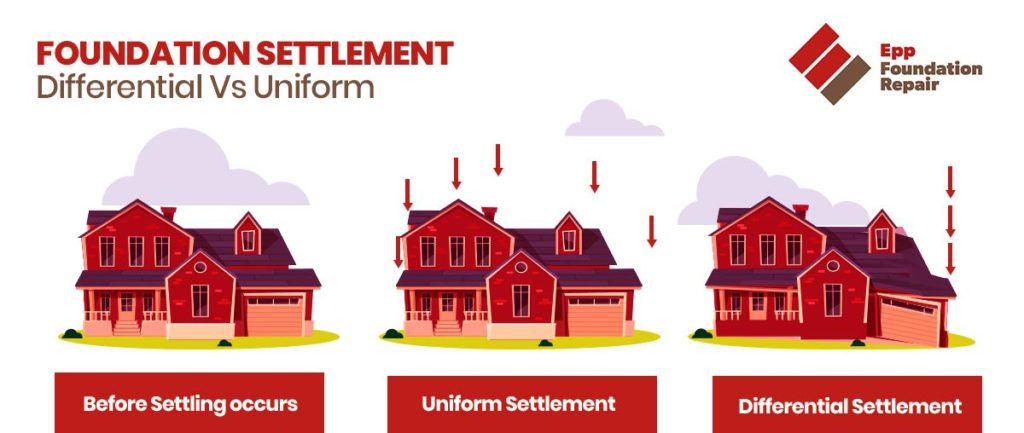
Differential settlement is caused by various things, including:
- Soil that wasn’t adequately compacted before construction started – Backfilled soil needs to be tamped down before anything gets built on top of it. If this isn’t done correctly, the structure will settle into the ground unevenly.
- Soil with a lot of clay in it – Soil with a high percentage of clay will expand as it absorbs moisture and shrink as it dries out. This usually seasonal phenomenon creates movement in the soil under the foundation leading to differential settlement.
- Weather changes – Suppose you build a house on clay soil during the dry season. When the wet season returns, the soil will swell, creating movement in the soil under the house. This could lead to differential settlement.
- Excavation next to the foundation – Heavy digging too close to your home’s foundation could cause the soil to become unstable, leading to differential settlement.
- Natural disasters like earthquakes, floods, etc. – We probably don’t need to explain how this causes foundation trouble.
- Poor construction – Never rule out poor construction. Sometimes it happens.
Is Foundation Leveling The Same As Foundation Repair?
No, foundation leveling is just one type of foundation repair. As we noted above, the term ‘’foundation leveling’’ usually refers to a foundation repair known as “underpinning.” Underpinning involves using piers – push piers, helical piers, slab piers, etc. – to transfer the structure’s load to soil that’s able to support it. Once the piers are in place, hydraulic jacks raise the structure back up.
Signs Your Home Might Need Foundation Leveling
Signs a house might need foundation leveling include:
- Wall cracks – Horizontal and diagonal wall cracks are a sign the house is experiencing foundation movement. However, a series of vertical cracks next to each other is also problematic.
- Trouble opening and closing windows and doors – If this is just one door or window, it might not be a foundation problem. However, if you’re noticing trouble with multiple doors and windows, that’s a sign the foundation has moved.
- Floor cracks – If the crack is limited to a couple of tiles, it probably happened when something heavy fell on the floor. However, a larger crack or a wall-to-wall crack indicates a problem with the foundation.
- Uneven floors – The unevenness may be barely noticeable.
- Ceilings and floors that are separating from the wall – The separation might be very slight.
- Wrinkled or torn wallpaper – This could be a sign the wall behind the wallpaper is cracked.
- Diagonal cracks from the corners of windows and doors – If these cracks are hairline, it might not indicate a foundation problem. However, larger cracks are a sign the foundation has moved.
- Moldings that are pulling away from the wall and ceiling – Even a slight separation is a red flag.
- Stair step cracks in brickwork – Stair step cracks are a sure sign of foundation movement.
- Chimneys and porches that are separating from the house – The problem might be the foundation under the chimney or porch, or the problem could be the foundation under the house.
Foundation Leveling Methods
The two most common foundation leveling methods are:
- Resistance push piers – These piers are driven into the ground under the foundation using hydraulic pressure and the weight of the building. Once they’re in place, synchronized hydraulic jacks will attempt to raise the structure. However, this isn’t always possible. In fact, more than likely the push piers will only stabilize the structure to prevent further settlement.
- Helical piers – While helical piers are usually used for new construction projects requiring a deep foundation, they’re also sometimes used for foundation leveling.
How Much Does Foundation Leveling Cost?
The cost of foundation leveling depends on your geographical location, the type and severity of the problem, and the chosen repair solution. Therefore, it’s impossible for us to give you an estimate. If you think your home might need foundation leveling, contact a foundation repair contractor in your area and ask for an inspection and estimate.
How To Prevent Foundation Trouble
Since most foundation problems are caused by water, the best way to prevent foundation trouble is to control groundwater around your home’s foundation. Here are some ways to do that:
- Regrade your yard, if necessary – The yard around your home should slope away from the foundation. This is to prevent water from draining toward the foundation.
- Install downspout extensions – Your downspouts should release water no less than four feet from the foundation. If they’re too short, install extensions.
- Install an underground downspout with a pop-up emitter – An underground downspout channels runoff from the gutters toward a small basin situated around 10 feet from your foundation. When the basin is empty, it sits flush with the ground and is barely visible on your lawn. When this basin fills will water, it pops up and releases the water away from the foundation.
- Ensure that your gutters are debris-free – You don’t want water spilling over the side of your home where it will soak into the soil around the foundation.
- Don’t plant flowers, shrubs, and other vegetation next to the foundation – They might look nice, but they need water.
- Install a drain tile system – A drain tile system is the best way to control groundwater around the foundation. For more information, see, How Does A Drain Tile System Work?
If you think your home might need foundation leveling and are in our service area in Nebraska, Iowa, Kansas, and Missouri, contact us today for an inspection and estimate.

